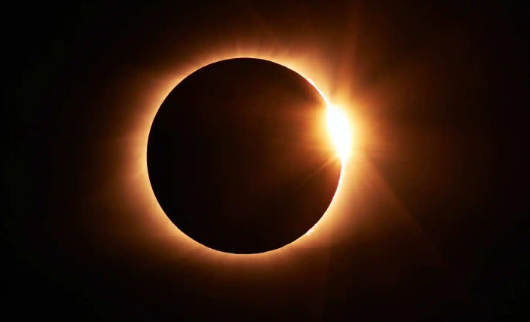This is your final opportunity to witness a solar eclipse in its entirety in the continental United States until 2044.
However, if you intend to witness the moon temporarily darken Earth by blocking the sun’s rays, make sure to shield your eyes.
Dr. David Hinkle, the chair of the department of ophthalmology at Tulane University School of Medicine in New Orleans, predicted that the eclipse will last a few minutes. “Eye damage can last a lifetime.”
He stressed that there is never, ever a safe moment to view an eclipse without wearing protective eyewear. That holds true for both those who are in the path of totality and those who live in a larger region of the country where there will only be partial solar blocking.
Also read- By 2050, Cancer Cases Are Expected To Increase 77% owing To An Aging Population

Solar Eclipse
The route of totality includes thirteen states, spanning from Texas to Maine. For one to four minutes, starting soon after 1 p.m. Eastern time (ET), the moon will totally obscure the sun.
It’s never a good idea to stare directly at the sun. Hinkle said, ‘It can burn your retina.
In a Tulane news release, Hinkle stated, “The sun’s rays are powerful and can burn your retina very quickly.”
This is due to solar retinopathy, a burn that results from the sun’s rays being focused directly onto the thin layer of tissue behind the back of the eye by the cornea and lens of the eye. This injury has the potential to be irreversible, resulting in legal blindness in both eyes.
Solar Eclipse

Solar Eclipse
Hinkle provided the following tips for safeguarding your eyes when seeing the uncommon celestial event:
- Wear the appropriate eye protection: Regular sunglasses, no matter how polarized, will not shield your eyes from the eclipse. The ISO 12312-2 filter, which filters out 99% or more of the light, is what you need for eclipse glasses. According to Hinkle, anything that allows enough light to pass through and allow you to move about is not safe.
- Make use of a pinhole viewer, a do-it-yourself tool that allows you to see the eclipse projected onto the ground. For details on how to make your own, see NASA.
- Watch it here on the web: Beginning at 1 p.m. ET, NASA will broadcast a live feed of the eclipse on its website.
- Filter your camera: If you intend to take pictures of the event, make sure that any telescopes, binoculars, or cameras you bring along are equipped with solar filters. You can get the information you need at the Massachusetts Institute of Technology.
Additionally, NASA has a guide online that provides information on safe eclipse viewing locations, times, and methods.
Solar Eclipse

Solar Eclipse
Also read-What You Should Know About Texas’s Uncommon Human Case of Bird Flu
images source: Google
Disclaimer: The opinions and suggestions expressed in this article are solely those of the individual analysts. These are not the opinions of HNN. For more, please consult with your doctor




































